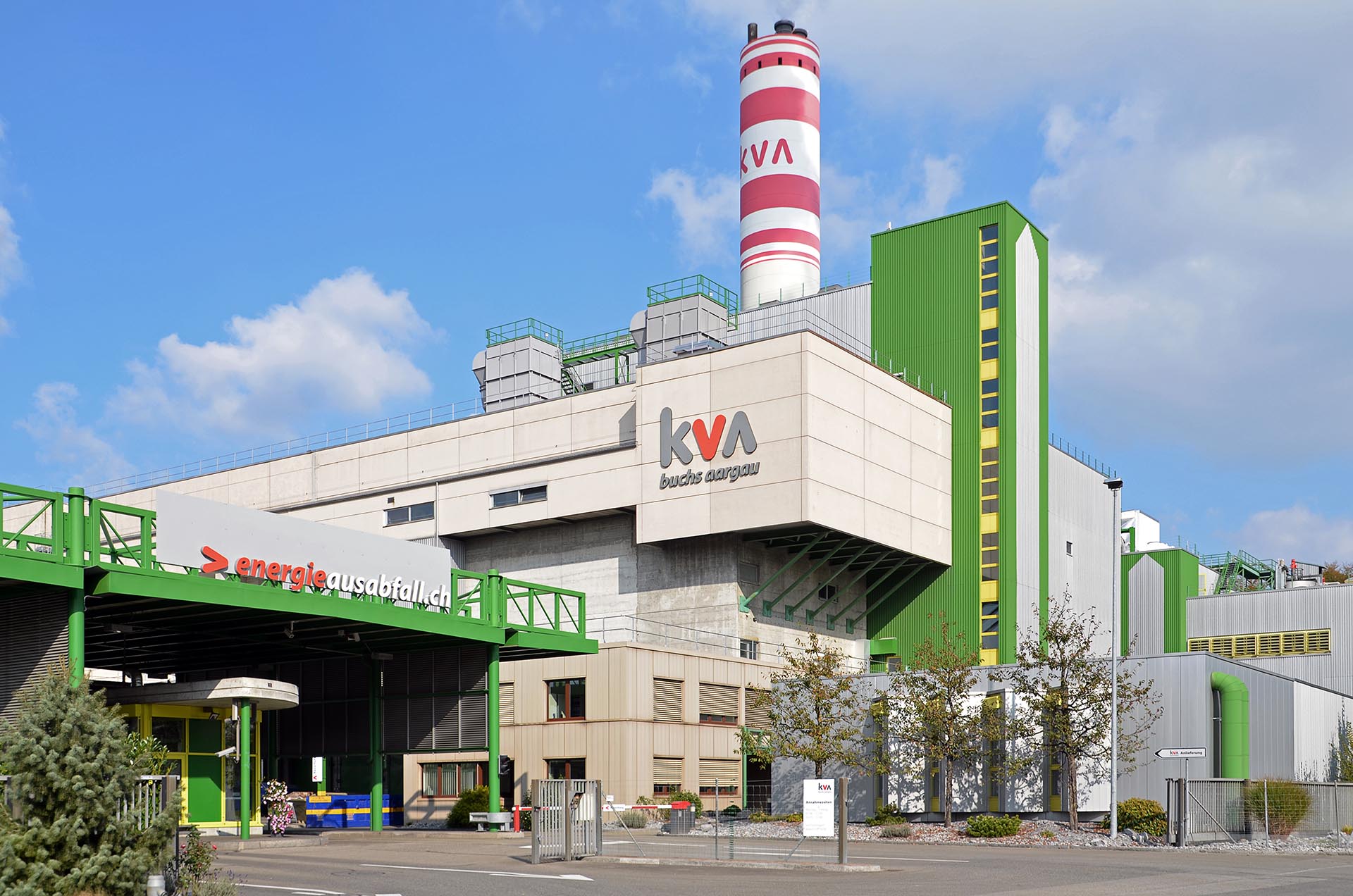
Hitachi Zosen Inova startet grüne Wasserstoff-Produktionsanlage
Hitachi Zosen Inova und der Gemeindeverband für Kehrichtbeseitigung Region Aarau-Lenzburg werden bei der Kehrichtverbrennungsanlage im schweizerischen Buchs (AG) zukünftig Wasserstoff produzieren. Hauptabnehmer des erzeugten Wasserstoffs ist die Messer Schweiz AG in Lenzburg. Es ist für HZI das zweite innovative Projekt im Kanton Aargau in kürzester Zeit; erst im September wurde die Lieferung einer CO2-Verflüssigungsanlage für ein Schweizer Pionierprojekt in Nesselnbach bekannt gegeben.
Buchs (AG), Schweiz. Im Rahmen der Energiewende zu erneuerbaren Energien hin wird grüner Wasserstoff als Energieträger mit hoher Dichte und geringem CO2-Fussabdruck wesentliche Bedeutung bekommen. Die kostengünstige Verfügbarkeit von grünem Wasserstoff ist der Schlüssel zum Erfolg der Energiewende. Dies kann in Städten mit kostengünstigem Überschussstrom aus erneuerbaren Energien erreicht werden. Durch seine Nähe zum Ort des Verbrauchs ist dieser ohne aufwändige Logistik verfügbar. Da es sich bei thermischen Abfallbehandlungsanlagen um Recyclinganlagen handelt, ist die Nutzung des erzeugten Stroms zur Herstellung von Wasserstoff ein weiterer Schritt zur Verbesserung des Beitrags solcher Anlagen zur Kreislaufwirtschaft. Die Wasserstofferzeugung kann entweder grundlastfähig oder fluktuierend sein. Durch diese Flexibilität kann die Verfügbarkeit anderer erneuerbarer Stromerzeugungsanlagen bestmöglich berücksichtigt werden, sodass bei hoher Wind- und Solarproduktivität mehr Wasserstoff produziert wird und umgekehrt. Da Wasserstoff ohne Verluste gespeichert werden kann, erweist sich diese chemische Speicherung als effektiver und skalierbarer als die Batteriespeicherung.
Nun wurde ein gemeinsames Projekt zusammen mit dem Gemeindeverband für Kehrichtbeseitigung Region Aarau-Lenzburg (GEKAL) ins Leben gerufen, bei dem das schweizerisch-japanische Cleantech-Unternehmen Hitachi Zosen Inova (HZI) eine erste Waste-to-Hydrogen (WtH2)-Anlage im kommerziellen Massstab bauen wird. HZI wird alle Planungs- und Bauarbeiten für die Anlage auf dem GEKAL-Gelände übernehmen und in den ersten Jahren auch Eigentümer und Betreiber sein. Der erzeugte Wasserstoff wird als technisches Gas für die Industrie und für Mobilitätsanwendungen genutzt, zum Beispiel als umweltfreundlicher Kraftstoff für den öffentlichen Nahverkehr und private Fahrzeuge.
HZI erzeugt Wasserstoff und Sauerstoff mithilfe von Strom aus der Kehrrichtverbrennungsanlage (KVA) Buchs und reinem Wasser. Der Sauerstoff wird an die Umgebung abgegeben, der Wasserstoff verdichtet und in speziellen Tanks gelagert. Hierzu setzt HZI einen alkalischen Elektrolyseur ein, der 550 Nm3/h grünen Wasserstoff bei 350 bar produziert. Dieser entspricht dem Qualitätsstandard für Wasserstoff für Mobilitätszwecke gemäss SAE 2719 und ISO 14687. Die Power-to-Gas-Anlage umfasst auch eine Abfüllstation. Geplant ist eine Produktion von rund 200 Tonnen Wasserstoff pro Jahr, das entspricht ca. 10 bis 15 Gigawattstunden Strom. Das genügt, damit ein mit Wasserstoff betriebener PKW rund 20 Millionen Kilometer weit fahren kann oder aber bis zu 1000 Brennstoffzellenfahrzeuge pro Jahr betankt werden können. Die in Lenzburg ansässige Messer Schweiz AG, die einen Vertrag über die Abnahme des produzierten Wasserstoffs abgeschlossen hat, ist auf die Versorgung mit Industriegasen spezialisiert. Nach der Inbetriebnahme wird die neue PtH2-Anlage eine wertvolle und vor allem lokale Quelle für grünen Wasserstoff darstellen und den Kreislaufgedanken der thermischen Verwertungsanlage verstärken.
Die Wasserstoffanlage wird nach Errichtung im Rahmen der Swissgrid SRL-Dienstleistungen eingebunden. Dieses neuartige Konzept regelt Bedarf und Überproduktion im Schweizer Stromnetz. Wenn ein Primärerzeuger im Netz ausfällt, tragen Sekundärerzeuger, beispielsweise die KVA Buchs, über Stromeinspeisung zur Stabilisierung des Netzes bei. Möglich ist ebenfalls ein sogenannter «negativer Netzausgleich», falls im Vergleich zum Plan zu viel erneuerbarer Strom produziert wird. Die Wasserstoffanlage kann in diesem Fall bis zu 2 MW aus dem Netz entnehmen. Die Erzeuger der erneuerbaren Energien (wie beispielsweise Windkraftanlagen) müssen dann nicht oder erst später abgeschaltet werden.
Ein kosteneffizientes und umweltfreundliches Gemeinschaftswerk
Die Errichtung der Wasserstoff-Anlage bietet in ökonomischer und ökologischer Hinsicht viele Vorteile. GEKAL-Präsident Christoph Wasser sagt: «Die Wasserstoffproduktion ermöglicht uns eine deutlich höhere Flexibilität, wenn beispielsweise die Nachfrage nach Strom gering ist. In diesem Fall speisen wir nicht Strom in das Netz ein, sondern produzieren speicherbaren Wasserstoff.» Fabio Dinale, Vice President Business Development bei HZI, ergänzt: «Die Nutzung der produzierten Energie der KVA Buchs wird sich durch die Wasserstoff-Anlage deutlich verbessern. Durch die Kompensation der Produktion fossiler Energieträger verringern wir ausserdem die CO2-Bilanz der Anlage. In Zukunft sind auch weitere attraktive technische Lösungen denkbar, wie beispielweise die Kombination des Wasserstoffs mit aus den Abgasen der KVA Buchs abgeschiedenem CO2. Das ermöglicht einen Produktionszyklus für Methan.» Dr. Hans Michael Kellner, CEO der Industriegasspezialistin Messer Schweiz AG, fügt hinzu: «Für uns als Abnehmer des Wasserstoffs ist die Errichtung der Anlage eine ideale Gelegenheit, den Anteil grünen Wasserstoffs in unserem Portfolio deutlich zu erhöhen. Nach der Inbetriebnahme der Power-to-Hydrogen-Anlage wird der lokal produzierte grüne Wasserstoff fast ein Drittel unseres heutigen lokalen Versorgungsvolumens ausmachen.»
Baubeginn der Wasserstoff-Anlage bei der KVA Buchs ist im Juni 2022 geplant, die erste Wasserstoffproduktion soll Anfang 2023 stattfinden und die volle Inbetriebnahme dann wenige Monate später, im Frühjahr 2023.

